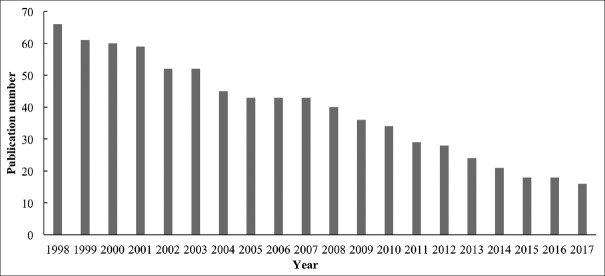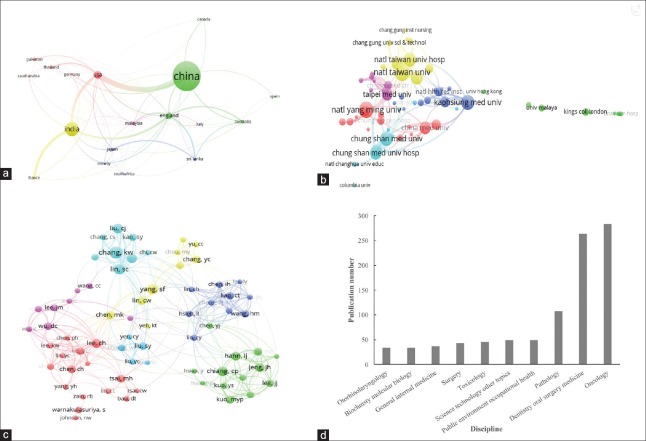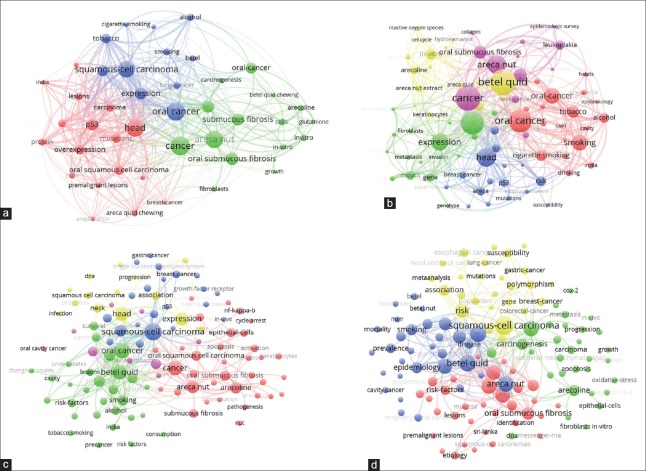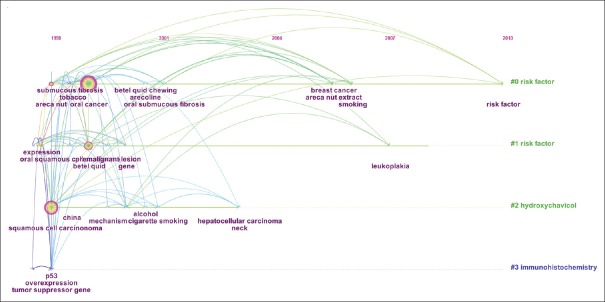Abstract
Background:
Betel quid chewing has been a major risk factor for oral cancer (OC) in southern China. This study aimed to analyze the scientific publications on the relationship between betel quid chewing and OC and construct a model to quantitatively and qualitatively evaluate pertinent publications from 1998 to 2017.
Methods:
The publications from 1998 to 2017 were retrieved from the Web of Science Core Collection database. Microsoft Excel, Thomson Data Analyzer, VOSviewer, and CiteSpace software were used to analyze the publication outcomes, journals, countries/regions, institutions, authors, research areas, and research frontiers.
Results:
A total of 788 publications on the relationship between betel quid chewing and OC published until October 25, 2017, were identified. The top 4 related journals were Journal of Oral Pathology Medicine, Oral Oncology, Plos One, and International Journal of Cancer. The top five countries engaged in related research included China, India, the United States, the United Kingdom, and Malaysia. The corresponding disciplines, such as oncology, oral surgery, pathology, environmental and occupational health, and toxicology, were mainly concentrated in three disciplines. The subject terms squamous cell carcinoma, OC, betel quid, expression, oral submucous fibrosis, India, and p53 ranked first among research hotspots. The burst terms squamous cell carcinoma, OC, betel quid, and expression ranked first in research frontiers.
Conclusions:
Research in this area emphasized hotspots such as squamous cell carcinoma, OC, oral submucosal fibrosis, betel quid, and tobacco. The annual number of publications steadily decreased from 1998 to 2017, with a lack of a systematic study from interdisciplinary perspectives, inadequate pertinent journals, limited regions with the practice of betel quid chewing, and insufficient participation of researchers, which indicate that as the prevalence of OC increases, particularly in China, research in this area warrants further expansion.
Keywords: Betel Quid, Bibliometric, CiteSpace, Oral Cancer, VOSviewer
摘要
背景:
嚼食槟榔已成为中国南方地区口腔癌的主要危险因素。本研究旨在分析关于嚼食槟榔与口腔癌的关系的科学文献,建立自 1998 到 2017 年相关发表文献的数量和质量评估模型。
方法:
从Web of Science 核心数据库检索自1998到2017年相关发表的文献。运用Microsoft Excel, Thomson Data Analyzer, VOSviewer 和 CiteSpace software 来分析文献来源、结果、杂志、国家/地区、机构、作者、研究领域和研究前沿热点。
结果:
从 1998 到 2017 年10月25日,总共发表了 788 篇文献关于嚼食槟榔和口腔癌关系。排名前4的杂志分别为Journal of Oral Pathology Medicine,、Oral Oncology、Plos One 和 International Journal of Cancer. 参与研究的前5的国家包括中国、印度、美国、 英国和马来西亚。相关的学科包括: oncology、 oral surgery、pathology、environment 、occupational health,、和toxicology. 其 中研究主题词 squamous cell carcinoma、oral cancer, betel quid、expression、oral submucous fibrosis 和 p53 为主要研究热点。研 究前沿热点的主题词包括 squamous cell carcinoma、oral cancer、betel quid 和 expression。
结论:
在该领域的研究研究热点包括squamous cell carcinoma、oral cancer、oral submucosal fibrosis、 betel quid和tobacco。但自 1998 到 2017 年来,每年发表的相关文献逐年减少。从跨学科视角、缺乏较少的相关杂志、有限的研究领域和有限的相关研 究人员等方面来看,该领域研究在系统性方面有所缺乏。以上结果表明,尤其在中国,随着口腔癌的发病率逐年升高,该领 域的相关研究和探索需要进一步的拓展。
INTRODUCTION
Oral cancer (OC) refers to malignancies developing in the oral cavity. It is one of the most common head and neck cancers.[1,2] Squamous cell carcinoma of the oral cavity constitutes over 90% of head and neck cancers.[3] The incidence of OC is increasing worldwide, especially among young women. Nearly 274,000 new OC cases occur worldwide each year, with 128,000 deaths. The relevant risk factors for contracting OC include betel quid chewing, tobacco use, alcohol consumption, poor diet, biological infections, and oral chronic inflammation.[4] Although many advances in clinical cancer treatments have been made, good outcomes have not been reflected in mortality figures since the 1960s, with the 5-year survival rate hovering at approximately 50%.[5] In developing countries/regions, featuring a cultural practice of betel quid chewing, there has been a high incidence of OC, mainly in southeast Asian countries such as India, Sri Lanka, and Thailand, as well as in southern China, such as in Taiwan area, Hunan Province and Guangxi Zhuang Autonomous Region. It ranks first among all cancers in India (≥50%),[6] whereas a low incidence has been observed in developed countries such as Europe, the United States, and Japan.[7] The World Health Organization study showed that 60% of OC s may be attributed to betel quid chewing, which has a close association with oral mucosal fibrosis, oral leukoplakia, and oral erythema. Therefore, in Southeast Asian areas, OC is highly prevalent due to the ancient custom of chewing quid.[8] According to data from the National Central Cancer Registry of China, in 2009,[9] OC and throat cancer had a crude incidence of 3.28/100,000, with 4.15/100,000 for males and 2.39/100,000 for females, showing an increasing trend.[10] In Taiwan, China, the incidence of OC was approximately 27.4/100,000.[11] OC involves not only varying factors and stages but also aberrant expression of many genes in cancer development. By activating oncogenes or suppressing the function of tumor suppressor genes, predisposing factors, including physics, chemistry and microorganisms, disturb oncogene regulation, and cause functional mutations, showing uncontrolled cell proliferation and abnormal apoptosis.[12]
Our research purpose was to provide more evidence for the clinical study of OC. In terms of the relationship between betel quid chewing and OC, a series of studies on basic medicine, clinical care, and epidemiology have been conducted worldwide with numerous papers published. However, no researcher has used a bibliometric approach to summarize these papers and assess the distribution of different countries/regions, institutions and researchers, as well as research areas, hotspots, frontiers in particular areas and trends. Hence, according to publications on the relationship between betel quid chewing and OC from the Science Citation Index (SCI) and the Social SCI (SSCI) of the Web of Science Core Collection (WoSCC), two types of bibliometric visualization software, Thomson Data Analyzer (TDA) and VOSviewer, were used to detect and analyze pertinent research hotspots, frontiers, and trends.
METHODS
Data
Publications on the relationship between betel quid chewing and OC were gathered from the SCI and the SSCI of the WoSCC of Thomson Scientific on October 25, 2017. A total of 788 pertinent articles were available with duplicates excluded from the study.
Search strategy
The following search terms were used: (TS = [“oral cancer” OR “oral Carcinoma” OR “Mouth Neoplasm” OR “Neoplasm, Mouth” OR “Neoplasms, oral” OR “Neoplasm, oral” OR “oral Neoplasm” OR “oral Neoplasms” OR “Neoplasms, Mouth” OR “Cancer of Mouth” OR “Mouth Cancers” OR “Mouth Cancer” OR “Cancer, Mouth” OR “Cancers, Mouth” OR “oral Cancer” OR “oral carcinoma” OR “Cancer, oral” OR “Cancers, oral” OR “oral Cancers” OR “Cancer of the Mouth” OR “Mucosa, Mouth” OR “oral Mucosa “ OR “Mucosa, oral” OR “Buccal Mucosa” OR “Buccal cancer” OR “Buccal carcinoma” OR “Neoplasm, Tongue” OR “Tongue Neoplasm” OR “Neoplasms, Tongue” OR “Cancer of Tongue” OR “Tongue Cancers” OR “Lingual cancer” OR “Lingual carcinoma” OR “Tongue carcinoma” OR “Tongue Cancer” OR “Cancer, Tongue” OR “Cancers, Tongue” OR “Cancer of the Tongue” OR “Neoplasms, Gingival” OR “Gingival Neoplasm” OR “Neoplasm, Gingival” OR “Carcinomas, Squamous Cell” OR “Squamous Cell Carcinomas” OR “Squamous Cell Carcinoma” OR “Carcinoma, Squamous” OR “Carcinomas, Squamous” OR “Squamous Carcinoma” OR “Squamous Carcinomas”] OR TI = [“oral cancer” OR “oral Carcinoma” OR “Mouth Neoplasm” OR “Neoplasm, Mouth” OR “Neoplasms, oral” OR “Neoplasm, oral” OR “oral Neoplasm” OR “oral Neoplasms” OR “Neoplasms, Mouth” OR “Cancer of Mouth” OR “Mouth Cancers” OR “Mouth Cancer” OR “Cancer, Mouth” OR “Cancers, Mouth” OR “oral Cancer” OR “oral carcinoma” OR “Cancer, oral” OR “Cancers, oral” OR “oral Cancers” OR “Cancer of the Mouth” OR “Mucosa, Mouth” OR “oral Mucosa “ OR “Mucosa, oral” OR “Buccal Mucosa” OR “Buccal cancer” OR “Buccal carcinoma” OR “Neoplasm, Tongue” OR “Tongue Neoplasm” OR “Neoplasms, Tongue” OR “Cancer of Tongue” OR “Tongue Cancers” OR “Lingual cancer” OR “Lingual carcinoma” OR “Tongue carcinoma” OR “Tongue Cancer” OR “Cancer, Tongue” OR “Cancers, Tongue” OR “Cancer of the Tongue” OR “Neoplasms, Gingival” OR “Gingival Neoplasm” OR “Neoplasm, Gingival” OR “Carcinomas, Squamous Cell” OR “Squamous Cell Carcinomas” OR “Squamous Cell Carcinoma” OR “Carcinoma, Squamous” OR “Carcinomas, Squamous” OR “Squamous Carcinoma” OR “Squamous Carcinomas”]) AND ([betel OR Areca] OR TI = [betel OR Areca]). The literature research was performed for articles from 1998 to 2017 on October 25, 2017.
Analysis methods
We reviewed the characteristics of the related publications, including the distribution of countries/regions, institutions, journals, authors, and research areas, based on the WOSCC database. In addition to the TDA, VOSviewer (Van Eck & Waltman, Leiden University, The Netherlands), and CiteSpace software (Chaomei Chen, Drexel Univerisity, USA), three types of bibliometric visualization software, Microsoft Excel, and Pathfinder[13] were used for data mining and bibliometric analysis of the retrieved articles to generate and analyze knowledge maps. Moreover, we sought to identify research frontiers and trends by analyzing significant publications, representative institutions, authors, and research hotspots as well as by recognizing burst keywords over time to systematically explore the knowledge structure and trends of the pertinent papers from 1998 to 2017.
In light of the TDA 6.0 User's Guide from Thomson Scientific (http://thomson-data-analyzer.software.informer.com/), TDA was used for data preprocessing, such as duplicate removal and word segmentation to form analysis matrices, including the co-occurrence matrix and factor matrix; then, several calculation methods, such as Pearson and cosine, were used for data standardization, and knowledge maps were formed by means of visualization technology.[14,15] In addition, VOSviewer, a literature visualization analysis software program developed by the Netherlands Leiden University (http://www.vosviewer.com/), was applied to visualize knowledge units and generate four types of view maps, including tag view, density view, cluster view, and decentralized view.[16,17] CiteSpace was used to perform a co-occurrence time view analysis of the keywords and generate co-citation maps of the items mentioned above.[18]
RESULTS
Distribution by time
A total of 788 publications from 1998 to 2017 were retrieved, and the overall trend of publication decreased from 67 publications in 1998 to 18 publications in 2016 (publications in 2017 were excluded from the data sample because of database coverage and the update cycle; Figure 1).
Figure 1.
Trend in the number of publications on the relationship between betel quid chewing and oral cancer from 1998 to 2017.
Distribution by journal
Regarding the 788 publications, the top 10 related journals included Journal of Oral Pathology Medicine (11.68%), Oral Oncology (9.90%), Plos One (4.82%), and International Journal of Cancer (3.55%), among which International Journal of Cancer (6.513) had the largest impact factor (IF), followed by Carcinogenesis (5.105) and Oral Oncology (4.79). Of the top 10 journals, International Journal of Cancer, Carcinogenesis, Oral Oncology, Plos One, Head and Neck, and Journal for the Sciences and Specialties of the Head and Neck were classified as Q1, Journal of Oral Pathology Medicine, Oral Diseases, and Journal of the Formosan Medical Association were classified as Q2, and the Asian Pacific Journal of Cancer Prevention was classified as Q3 [Table 1].
Table 1.
The top 10 journals with publications on the relationship between betel quid chewing and oral cancer from 1998 to 2017
| Number | Journal | Count | Percentage | IF2016 | Quartile in category (2016) |
|---|---|---|---|---|---|
| 1 | Journal of Oral Pathology Medicine | 92 | 11.68 | 2.043 | Q2 |
| 2 | Oral Oncology | 78 | 9.90 | 4.794 | Q1 |
| 3 | Plos One | 38 | 4.82 | 2.806 | Q1 |
| 4 | International Journal of Cancer | 28 | 3.55 | 6.513 | Q1 |
| 5 | Head and Neck Journal for the Sciences and Specialties of the Head and Neck | 17 | 2.16 | 3.376 | Q1 |
| 6 | Oral Diseases | 17 | 2.16 | 2.011 | Q2 |
| 7 | Journal of the Formosan Medical Association | 15 | 1.90 | 1.969 | Q2 |
| 8 | Asian Pacific Journal of Cancer Prevention | 14 | 1.78 | 2.514 | Q3 |
| 9 | Carcinogenesis | 14 | 1.78 | 5.105 | Q1 |
The journal “Asian Pacific Journal of Cancer Prevention” has been excluded from the SCI since 2015, so its impact factor and classification in 2014 were used here; no statistical analysis on journals’ quartile in category was separately performed because of differences in the classification criteria of journals in various fields, where many disciplines, including cancer, oral cavity, and epidemics, are involved. SCI: Science Citation Index.
Distribution by country/region
The top 10 countries/regions engaged in the related research included China, India, the United States, the United Kingdom, and Malaysia, among which China had the most papers, followed by India and the United States. According to the top 10 listed countries/regions, India, China, and Sri Lanka, where betel quid chewing is a widely practiced cultural habit, had a relatively high prevalence of oral cancer with more relevant research conducted. For the published articles, China collaborated closely with the United States, the United Kingdom, Canada, India, and Australia. Nevertheless, substantial research collaborations were observed between India and other countries, such as the United States, the United Kingdom, France, and Japan, which may be associated with the flow of researchers in OC-prone areas, countries and technological level [Table 2 and Figure 2a].
Table 2.
The top 10 countries/regions that contributed publications on the relationship between betel quid chewing and oral cancer from 1998 to 2017
| Number | Country/region | Count | Percentage | Citation count | Average citation count |
|---|---|---|---|---|---|
| 1 | China | 495 | 62.74 | 10648 | 21.51 |
| 2 | India | 157 | 19.92 | 2818 | 17.95 |
| 3 | USA | 70 | 8.88 | 1571 | 22.44 |
| 4 | England | 55 | 6.98 | 1339 | 24.35 |
| 5 | Malaysia | 22 | 2.79 | 265 | 12.05 |
| 6 | Japan | 20 | 2.54 | 480 | 24.00 |
| 7 | Sri Lanka | 20 | 2.54 | 364 | 18.20 |
| 8 | Australia | 19 | 2.41 | 468 | 24.63 |
| 9 | Norway | 6 | 0.76 | 147 | 24.50 |
| 10 | South Africa | 5 | 0.62 | 84 | 16.80 |
The total number of articles contributed by all countries/regions may not be 788 as originally searched because some of these were written with the cooperation of authors from different countries/regions.
Figure 2.
Network map of publications on the relationship between betel quid chewing and oral cancer from 1998 to 2017. Countries/regions’ contributions (a). Institutions’ contributions (b). Authors’ contributions (c). Disciplines covered by publications (d). Note: In the figures above, each color signifies items belonging to a certain cluster, and the size of the item's circle indicates the weight of the item, while links are displayed using lines; the stronger the link between two items, the thicker the line. The total number of articles contributed may not be 788 as originally searched because some involved the cooperation of multiple authors, institutions and countries.
Distribution by institutions
The top 10 institutions engaged in relevant research included the following: National Taiwan University, National Yang-Ming University, Kaohsiung Medical University, Chung Shan Medical University, and National Taiwan University Hospital, fully reflecting the great concerns regarding the association between OC and betel quid chewing shown by institutions in Taiwan area and the prevalence of OC. Similarly, institutions in Malaysia also paid close attention to these issues with their research. However, apart from the cooperation among the top three institutions, there was little cooperation between other institutions [Figure 2b].
Distribution by author
The top 10 authors and their institutions responsible for the 788 articles were as follows: Chang, KW from the School of Dentistry, National Yang-Ming University ranked first, followed by Lee, CH from the Department of Public Health, Kaohsiung Medical University; Lin, SC from the School of Dentistry, National Yang-Ming University; and Wang, HM and Liao, CT from the Department of Otolaryngology-Head and Neck Surgery, Chang Gung Memorial Hospital. However, geographic variation in researchers and institutions was noted, with little cooperation observed between them [Table 3 and Figure 2c].
Table 3.
The top 10 authors and their institutions that contributed publications on the relationship between betel quid chewing and oral cancer from 1998 to 2017
| Author | Institution | Count | Citation count | Average citation count | |
|---|---|---|---|---|---|
| 1 | Chang KW | School of Dentistry, National Yang-Ming University | 45 | 1401 | 31.13 |
| 2 | Lin SC | School of Dentistry, National Yang-Ming University | 35 | 1574 | 44.97 |
| 3 | Leei CH | Department of Public Health, Kaohsiung Medical University | 28 | 556 | 19.86 |
| 4 | Wang HM | Department of Otolaryngology-Head and Neck Surgery, Chang Gung Memorial Hospital | 20 | 661 | 33.05 |
| 5 | Liao CT | Department of Otolaryngology-Head and Neck Surgery, Chang Gung Memorial Hospital | 21 | 607 | 28.90 |
| 6 | Jeng JH | School of Dentistry, National Taiwan University | 26 | 797 | 30.65 |
| 7 | Hahn LJ | School of Medical, National Taiwan University | 27 | 784 | 29.04 |
| 8 | Chiang CP | School of Dentistry, National Taiwan University | 31 | 649 | 20.94 |
| 9 | Chen IH | Department of Otolaryngology-Head and Neck Surgery, Chang Gung Memorial Hospital | 16 | 588 | 36.75 |
| 10 | Ko YC | Medical School, China Medical University | 20 | 374 | 18.70 |
The total number of articles contributed by all authors may not be 788 as originally searched because some of these were written with the cooperation of multiple authors.
Distribution by discipline
Several disciplines, such as oncology (35.91%), oral surgery (33.50%), pathology (13.58), environmental and occupational health (6.22%), modern technology frontier (6.22%), and toxicology (5.71%), represented the vast majority of research areas covered by the 788 articles, which were mainly concentrated into three disciplines: oncology, oral surgery, and pathology (83%) [Figure 2d].
Distribution by keyword
The keywords (or subject terms) extracted from the 788 articles included the following: squamous cell carcinoma, OC, betel quid, areca nut, expression, tobacco, oral submucous fibrosis, cigarette smoking, arecoline, carcinogenesis, alcohol, India, p53, leukoplakia, lesions, epithelial cell, and esophageal cancer, which had significant correlations with emphasis on such vital keywords as squamous cell carcinoma, OC, betel quid, areca nut, and expression [Figure 3]. According to changes in the annual number of publications, the period from 1998 to 2017 was divided into four stages of 5 years each, and the corresponding keywords varied across the different stages. During 1998–2002, major keywords included squamous cell carcinoma, OC, p53 and expression, and cooperative research was interpenetrative and integrative. During 2003–2007, studies were related to the association of betel quid and arecoline with squamous cell carcinoma, OC, p53 and expression, and more collaborations were observed, especially in Taiwan, China. Moreover, several studies from 2008 to 2012 concerning the relationship among squamous cell carcinoma, OC, betel quid, and arecoline were further highlighted, with collaborative research gradually expanding to the field of head and neck cancer [Figure 4a–4d].
Figure 3.
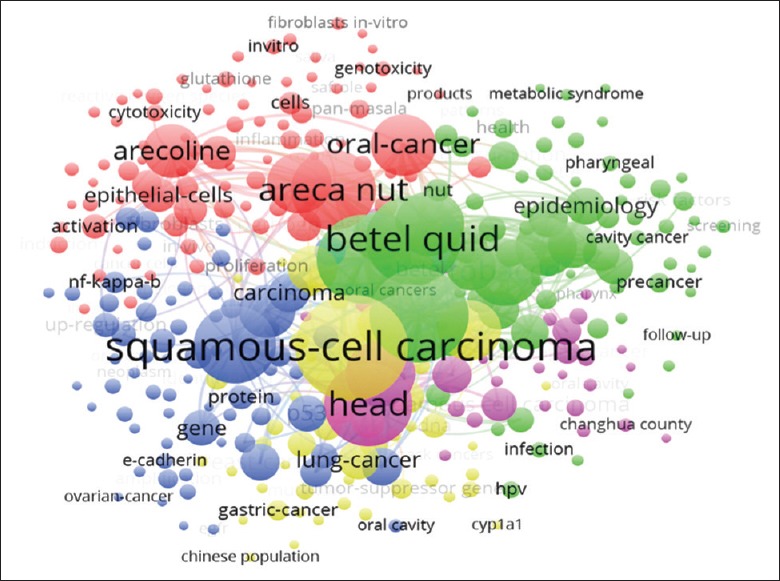
Network map of keywords in publications on the relationship between betel quid chewing and oral cancer, 1998 to 2017.
Figure 4.
Network map of keywords in publications on the relationship between betel quid chewing and oral cancer in periods. 1998–2002 (a), 2003–2007 (b), 2008–2012 (c), and 2013–2017 (d).
Analysis of burst terms
Identified as a prominent representative of the research frontier in the field of disciplinary knowledge, burst terms reflect the hotspots and frontiers in a specific field over time. The 15 burst terms with a value above 3.5, extracted from a sample of the literature, were analyzed with CiteSpaceII, which was available for word frequency analysis. Therefore, research frontiers and trends were explored based on the time distribution and changing trend in word frequency [Figure 5]. According to time spans and frequency, the burst terms included p53, mutation, overexpression, tumor suppressor gene, submucous fibrosis, oral submucous fibrosis, cigarette smoking, in vitro, smoking, expression, betel quid, neck cancer, tobacco, and areca nut. The following burst terms covered a large time span: oral submucous fibrosis, p53, mutation, overexpression, tumor suppressor gene, and submucous fibrosis. Meanwhile, the beginning and frequency of these burst terms were studied with CiteSpaceII, which provided a visual description of temporal trends. Four clusters were formed as a result of time series analysis and cluster analysis of burst terms, including risk factors such as betel quid, oral submucous fibrosis, smoking, and mutation as well as biotechnologies such as hydroxychavicol and immunohistochemistry, and each cluster was displayed from left to right to illustrate changing trends [Figure 6].
Figure 5.
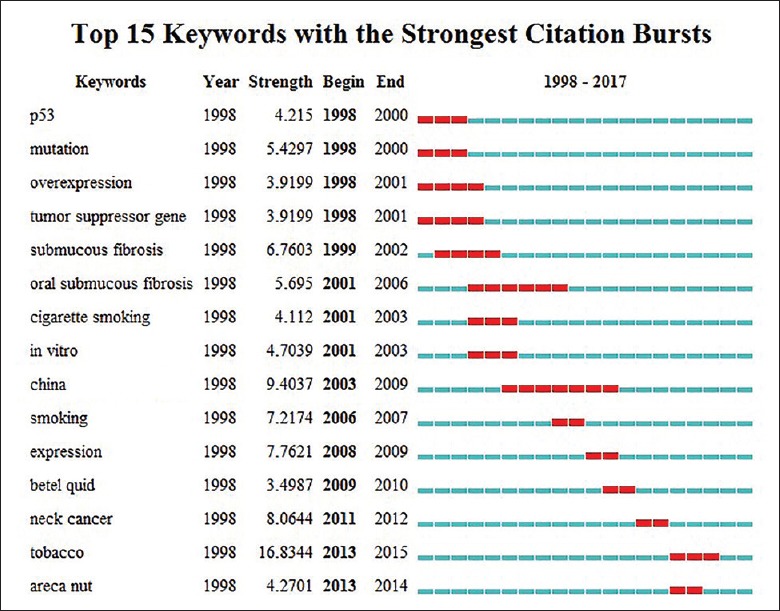
Burst terms in publications on the relationship between betel quid chewing and oral cancer from 1998 to 2017.
Figure 6.
Keyword co-citation map (timeline view) of publications on the relationship between betel quid chewing and oral cancer from 1998 to 2017. Note: Time line ends in 2010 because there were few co-citations after 2010.
DISCUSSION
In this study, TDA and VOSviewer were used to provide a bibliometric analysis of the relevant literature on betel quid chewing and OC, as well as a visual description of the research status and trends, which allowed for a systematic understanding of the past and future of research on the relationship between betel quid chewing and OC.
A total of 788 publications on betel quid chewing and OC were published from 1998 to 2017, and a downward trend was observed over time. The studies were mainly concentrated in three disciplines (83%): oncology, oral surgery, and pathology. They were contributed by the following journals: Journal of Oral Pathology Medicine, Oral Oncology, Plos One and International Journal of Cancer. These journals were chiefly classified as Q1 according to the IF, with the number of publications experiencing an annual decline; meanwhile, these studies were mostly from institutions and researchers from China, as well as from South Asian countries such as India, where high morbidity is commonly observed with the cultural practice of betel quid chewing, clearly representing local and regional characteristics. Particularly, in China, Taiwan area and Hunan Province, which have a high prevalence of OC, a large investment was made in pertinent research along with crucial contributions, which considerably exceeded those of any other country/region, enabling China to become a leading region in this field of study. Cooperating institutions were largely located in developed countries, such as the United States, the United Kingdom, Canada, Japan, Australia, and France, featuring apparent regionality and specific cooperation-based research strategies that were predominantly affected by the prevalence of OC, research conditions, technological capabilities, and flow trends in research.
Regarding the number and citation frequency of articles, Kuo-Wei Chang and Chia-Shu Lin from the School of Dentistry, National Yang-Ming University, were both in the top ranks, which made the counterpart of the School of Dentistry, National Yang-Ming University rank first among all institutions, acting as a leading institution. Regarding the keywords or subject terms present in published articles, the burst terms remarkably shifted, with China and India as the leading countries/regions, emphasizing such hotspots as squamous cell carcinoma, OC, oral submucosal fibrosis, betel quid, tobacco, alcohol, carcinogenesis, expression, p53, leukoplakia, and epithelial cell. Particularly, a series of studies were actively performed on oral squamous cell carcinoma, betel quid chewing, and expression, showing highly significant correlation and concentration. In other words, independent studies on oral squamous cell carcinoma, p53 and expression transitioned to research on the pathogenic roles of betel quid chewing and subsequently expanded to the field of head and neck cancer. However, no obvious changes in research hotspots were shown. According to the four clusters of burst terms formed, smoking, in vitro, betel quid, neck cancer, and tobacco covered a small time span, mainly involving oral submucous fibrosis, p53, mutation, overexpression, and tumor suppressor gene. As shown in Figure 4, cluster #3 (labeled immunohistochemistry) included p53, mutation, overexpression, and tumor suppressor gene; cluster #2 included risk factors such as alcohol, smoking, and oral submucous fibrosis coupled with biotechnologies such as hydroxychavicol. More burst terms were observed with progressively active research, notwithstanding the short duration. Then, an expanded study was carried out on related risk factors, including betel quid, mutation, and oral submucous fibrosis, which conferred increased activity to burst terms for approximately 10 years. In addition, further studies shed light on risk factors such as betel quid chewing, tobacco, and oral submucous fibrosis, lasting for nearly 20 years, which nevertheless maintained a descending trend with increasingly fewer burst terms, indicating that there were no breakthrough outcomes in research methods and technologies that still warranted accelerated development and innovation.
Overall, a decline in the number of articles may be attributed to modest changes in research hotspots, the lack of a systematic study from interdisciplinary perspectives, inadequate pertinent journals, a limited region with a practice of betel quid chewing, and the insufficient participation of researchers, which indicates that as the prevalence of OC increases, particularly in China, research in this area should be expanded, particularly adequate investment, personnel construction, and extensive interventions such as health education and the prevention of betel quid chewing.
The bibliometric analysis in this study was an exploratory attempt to provide a systematic analysis of the basic characteristics of the literature related to betel quid chewing and OC through visualization. The data analysis was relatively objective and comprehensive and systematically provided basic information on the association between betel quid chewing and OC over the past two decades, offering researchers easier access to the current scenario and trends of pertinent research at a macro level, as well as appropriate institutions and researchers for cooperation. Using such a macroscopic and qualitative method, we briefly described the current hotspots and underlying trends of a broad array of studies. However, because most articles in the WoSCC database were written in English, few non-English articles were included, resulting in incomplete literature research to some extent. Similarly, an analysis performed using a wealth of articles from the China CNKI database is still considered incomplete. Moreover, as there were substantial differences between the results of the bibliometric analysis and actual conditions of the research, some published high-quality articles may be undervalued due to the low citation frequency; furthermore, some articles published long ago may affect the analysis outcomes, particularly publications updated regularly in view of open data.
Financial support and sponsorship
This work was supported by the CAMS Innovation Fund for Medical Sciences (No. 2016-I2M-2-004).
Conflicts of interest
There are no conflicts of interest.
Acknowledgments
The authors would like to thank the Chinese Academy of Medical Science for supporting this study.
Footnotes
Edited by: Li-Shao Guo
REFERENCES
- 1.Shield KD, Ferlay J, Jemal A, Sankaranarayanan R, Chaturvedi AK, Bray F, et al. The global incidence of lip, oral cavity, and pharyngeal cancers by subsite in 2012. CA Cancer J Clin. 2017;67:51–64. doi: 10.3322/caac.21384. doi: 10.3322/caac.21384. [DOI] [PubMed] [Google Scholar]
- 2.Scully C, Bagan JV, Hopper C, Epstein JB. Oral cancer: Current and future diagnostic techniques. Am J Dent. 2008;21:199–209. [PubMed] [Google Scholar]
- 3.Chou CH, Chou YE, Chuang CY, Yang SF, Lin CW. Combined effect of genetic polymorphisms of AURKA and environmental factors on oral cancer development in Taiwan. PLoS One. 2017;12:e0171583. doi: 10.1371/journal.pone.0171583. doi: 10.1371/journal.pone.0171583. [DOI] [PMC free article] [PubMed] [Google Scholar]
- 4.Siegel RL, Miller KD, Jemal A. Cancer statistics, 2016. CA Cancer J Clin. 2016;66:7–30. doi: 10.3322/caac.21332. doi: 10.3322/caac.21332. [DOI] [PubMed] [Google Scholar]
- 5.Chen W, Zheng R, Baade PD, Zhang S, Zeng H, Bray F, et al. Cancer statistics in China, 2015. CA Cancer J Clin. 2016;66:115–32. doi: 10.3322/caac.21338. doi: 10.3322/caac.21338. [DOI] [PubMed] [Google Scholar]
- 6.Saghir F, Feldman LE. Treatment of head and neck cancer. N Engl J Med. 2008;358:1076. doi: 10.1056/NEJMc073274. [PubMed] [Google Scholar]
- 7.LeHew CW, Weatherspoon DJ, Peterson CE, Goben A, Reitmajer K, Sroussi H, et al. The health system and policy implications of changing epidemiology for oral cavity and oropharyngeal cancers in the United States from 1995 to 2016. Epidemiol Rev. 2017;39:132–47. doi: 10.1093/epirev/mxw001. doi: 10.1093/epirev/mxw001. [DOI] [PubMed] [Google Scholar]
- 8.Huang WL, Zhu SL, Zou YH. Incidence and Mortality of Oral Cancer in Registered Regions of Hunan in 2009-2012 (in Chinese) China Cancer. 2017;26:507–14. doi: 10.11735/j.issn.1004-0242.2017.07.A002. [Google Scholar]
- 9.Liu ST, Wu JF, Zheng RS, Zhang SW, Sun XB, Chen WQ. Incidence and mortality of oral cavity and pharyngeal cancer in China, 2009 (in Chinese) Chin J Prev Med. 2013;47:586–91. doi: 10.3760/cma.j.issn.0253-9624.2013.07.003. [PubMed] [Google Scholar]
- 10.Hu YJ, Chen J, Zhong WS, Ling TY, Jian XC, Lu RH, et al. Trend analysis of betel nut-associated oral cancer and health burden in China (in Chinese) Chin J Dent Res. 2017;20:69–78. doi: 10.3290/j.cjdr.a38271. doi: 10.3290/j.cjdr.a38271. [DOI] [PubMed] [Google Scholar]
- 11.Krishna Rao SV, Mejia G, Roberts-Thomson K, Logan R. Epidemiology of oral cancer in Asia in the past decade – An update (2000-2012) Asian Pac J Cancer Prev. 2013;14:5567–77. doi: 10.7314/apjcp.2013.14.10.5567. doi: 10.7314/APJCP.2013.14.10.5567. [DOI] [PubMed] [Google Scholar]
- 12.Muwonge R, Ramadas K, Sankila R, Thara S, Thomas G, Vinoda J, et al. Role of tobacco smoking, chewing and alcohol drinking in the risk of oral cancer in Trivandrum, India: A nested case-control design using incident cancer cases. Oral Oncol. 2008;44:446–54. doi: 10.1016/j.oraloncology.2007.06.002. doi: 10.1016/j.oraloncology.2007.06.002. [DOI] [PubMed] [Google Scholar]
- 13.Chen Y, Liu ZY, Chen J, Hou JH. History and Theory of Mapping Knowledge Domains (in Chinese) Stud Sci Sci. 2008;26:449–60. doi: 10.16192/j.cnki.1003-2053.2008.03.025. [Google Scholar]
- 14.Li J, Guo X, Shen S, Jovanovic A. Bibliometric mapping of “international symposium on safety science and technology (1998-2012) Procedia Eng. 2014;84:70–9. doi: 10.1016/j.proeng.2014.10.411. [Google Scholar]
- 15.Dang Y, Zhang Y, Hu JH, Brown SA, Chen H. Knowledge mapping for rapidly evolving domains: A design science approach. Decis Support Sys. 2011;50:415–27. doi: 10.1016/j.dss.2010.10.003. [Google Scholar]
- 16.van Eck NJ, Waltman L. Software survey: VOSviewer, a computer program for bibliometric mapping. Scientometrics. 2010;84:523–38. doi: 10.1007/s11192-009-0146-3. doi: 10.1007/s11192-009-0146-3. [DOI] [PMC free article] [PubMed] [Google Scholar]
- 17.Van Eck NJ, Waltman L. Vosviewer: A Computer Program for Bibliometric Mapping. Social Science Electronic Publishing; 2009;84:523–38. doi: 10.1007/s11192-009-0146-3. [DOI] [PMC free article] [PubMed] [Google Scholar]
- 18.Chen C, Ibekwe-Sanjuan F, Hou J. The structure and dynamics of cocitation clusters: A multiple-perspective cocitation analysis. J Assoc Inf Sci Technol. 2010;61:1386–409. doi: 10.1002/asi.21309. [Google Scholar]



